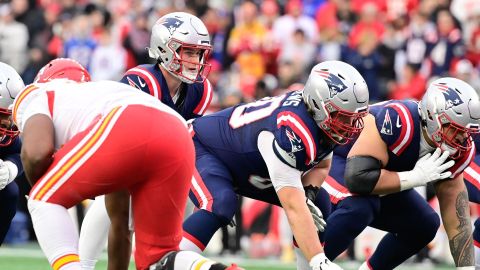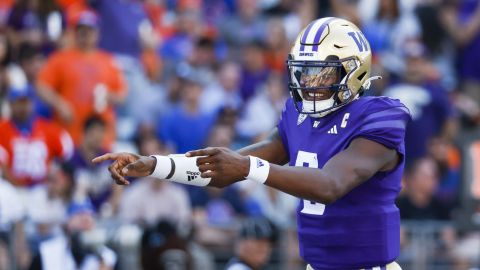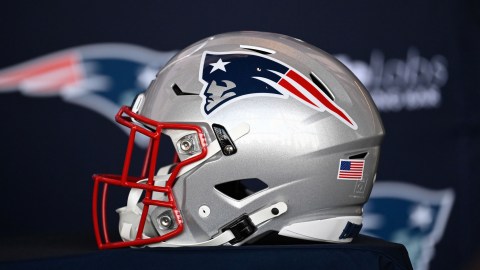 FOXBORO, Mass. — Kyle Arrington isn’t just playing cornerback when he steps on the field in the Patriots’ sub-package defense. He’s also playing safety and linebacker, according to Bill Belichick.
FOXBORO, Mass. — Kyle Arrington isn’t just playing cornerback when he steps on the field in the Patriots’ sub-package defense. He’s also playing safety and linebacker, according to Bill Belichick.
Arrington plays one of the toughest roles in an NFL defense: the nickel defensive back. Arrington’s reps have increased at the position this season as the team has spent the majority of their time in sub packages, meaning there are usually five defensive backs on the field: two cornerbacks, two safeties and one hybrid role, the slot.
The slot, or star position, takes over for the strong-side linebacker in a nickel defense. His main responsibility in man coverage is to take on the team’s slot receiver, typically a smaller, shiftier player who receives a high number of targets in most offenses. He also has a tremendous responsibility against the run, since he’s taking over for an outside linebacker. In zone coverages, his area of a the field is a busy one that any number of receivers, tight ends or running backs could be entering at any time.
As the Patriots prepare for the Saints, much of the focus has been on three players in New Orelans’ offense: Drew Brees, Darren Sproles and Jimmy Graham.
Sproles and Graham may be the toughest matchups for the Patriots, since New England’s linebackers have struggled covering running backs and tight ends in the past. The player who probably hasn’t received enough attention this week is Marques Colston. The 6-foot-4, 225-pound receiver spends the majority of his time in the slot for New Orleans. At his size, Coltson doesn’t look like the prototypical inside receiver, like Wes Welker, Danny Amendola, Victor Cruz or Tavon Austin.
“He’s a different kind of slot receiver, similar to Vincent Jackson who we see in Tampa when they put him in the slot,” Belichick said. “We’ve seen that from time to time. Some slot receivers are bigger, physical guys that create that type of mismatch. Other guys are quicker, short-area, explosive guys that create that type of matchup in there. He’s definitely a big guy that can get down the seam. He had a big play against Tampa that put them in position to kick the field goal to win the game. Those are the kind of plays that he can really hurt you on: vertical plays, crossing routes, flag patterns, seam patterns, things like that. He’s not as much of a run three or four yards and run return routes and things like that to get open. I’m not saying he can’t do that, but his thing is he’s more of a vertical receiver down the field.
“His size and his ball skills are a tough matchup, no question. Again, each team has its own type players and through the course of the year, we’ll match up against fast guys, big guys, quick guys, push-off guys, get open with technique — everybody has their own skill set. That’s the challenge every week, of matching up against whatever individual skills that particular team’s players have. But I’d say similar to Vincent Jackson, that type of concept of that player in the slot is similar.”
Despite his unusual size, Colston has the quicks and agility to play the position He ran a 6.96-second three-cone time coming out of college in 2006 (the three cone measures agility). He ran the 40-yard dash in 4.53 seconds and the 20-yard shuttle in 4.44. He’s been one of the most productive slot receivers in the NFL this season.
Colston has run 107 routes from the slot this year, according to Pro Football Focus. He’s been targeted 22 times and pulled in 17 receptions for 240 yards and a touchdown. He has one drop from the position.
Colston’s 77.3 percent catch rate is second in the NFL from the slot. He rates second to just Julian Edelman, who has caught 81.5 percent of passes thrown his way on routes from the position.
Guarding Colston will likely be the responsibility of his former Hofstra teammate, Arrington (two of only four former Hofstra players left in the NFL — the school discontinued its football program in 2009). Belichick could also decide to match up Aqib Talib with the big receiver. Arrington is the team’s chief slot cornerback, but the Patriots have a lot of versatility in their secondary. Arrington, Talib, Alfonzo Dennard, Steve Gregory and Devin McCourty have all guarded receivers out of the slot.
Arrington has been the team’s “starting” slot cornerback since 2011. Last season, when he was able to slide from the outside to the inside more permanently, the pass defense started to click.
“Playing in the slot is a little different than playing on the outside,” Arrington said. “It’s one of those things where you ‘re more in the middle of everything and that much means that the receiver has more grass, as well. You get to understand the concept of the defense. Each and every defense you’re in is definitely important each snap — know where your help is, know where your help isn’t.”
Belichick also said the slot is its very own position. It’s listed as a cornerback on paper, but the head coach compared the role to linebacker and safety.
“I think when you play inside, you’re really playing to a degree, a linebacker or a safety position,” Belichick said. “Even in man-to-man coverage, it’s different because the receiver has more options and the [slot] corner, if there is help, is closer to help than the [outside] corner is, if there’s some kind of inside help. If there’s no help, then the inside corner has more space to defend, across the ball or back outside as well as vertically compared to a corner who is more isolated in the area he has to defend. Once you get into a combination of zone coverages, then that player’s responsibility is either that of a safety or linebacker depending on the coverage and what exactly you’re playing. That brings in a whole different awareness and conceptually playing as a linebacker or a safety as opposed to playing as a corner, if that makes any sense.
“It’s not playing safety but it’s not playing corner. It’s a little bit of a hybrid spot. There’s certainly a lot of awareness, a lot of things that those players have to see that are unique. It’s not a linebacker, it’s not a corner, it’s a nickel position.”
Gregory said he feels comfortable moving down from safety to the slot. He’s been doing it for years. Back in 2009, he was the Chargers’ main nickel back.
“Yeah, there’s a lot of similarities,” Gregory said. “Especially in the zone coverages. Your drops are really the underneath type stuff. Yeah, it can be similar to a linebacker position because when you get in those spots, it’s really taking place for the outside linebacker.”
Dennard and Talib rarely played in the slot last season, but have upped their reps in the position this season. Both players’ started to get more versatile, starting in Week 3 as they were covering Jackson and Mike Williams, who the Buccaneers like to move all over the field.
“I say it’s kind of like being on the outside,” Dennard said. “You’re still going to have to do the same thing you’re going to do outside. Still gonna play the press the same, still play the same position, it’s still the same thing basically.”
Rookie Logan Ryan has also spent some time in that role. His skill set coming out of Rutgers suggested he may be destined for that position since he doesn’t have elite top-end speed, but he’s a great tackler and run defender and he’s best when the ball and his receiver are in front of him.
Ryan said his main concern when he’s playing cornerback in any role is to keep the receiver from catching the ball. But he does see a difference when he’s playing inside.
“It’s just a different position,” Ryan said. “There are a lot of similarities, obviously, but it’s a different position and some guys are great at one and not great at the other. I think all the defensive backs on this team, we pride ourselves and try to be versatile and be able to play in and out.”
Dennard mentioned that there are more responsibilities in the run game when he’s playing inside. Both Dennard and Ryan said they can see Belichick’s comparisons to playing linebacker when it comes to contributing against the run.
One of the biggest differences between playing the slot and playing outside is that the right and left cornerbacks have the sideline to protect them. The slot cornerback has to roam around the field, but they have more help in the middle with linebackers and safeties scattered around the field.
“Well, I’m just trusting my teammates,” Dennard said about not having the sideline as protection. “We got good safeties. I’m just trusting my teammates and go out there, play what I’m supposed to do, do what I’m supposed to do.”
“You’re playing in more space, but you also have a lot of defenders around you,” Ryan said. “So, you have to know how to use your help when you have it. And you gotta really play to the strength of the defense. Then it all plays the same.”
Belichick said the nickel defensive back role is difficult due to the amount of responsibilities he has. In man coverage, the cornerbacks’ main responsibility is to shadow their receiver. They have to be cognisent of the run, but they’re further than the slot cornerbacks to the ball.
“All positions are difficult but I think it’s a difficult position to play because of the amount of things that happen and how fast they happen,” Belichick said. “Tight ends and backs coming in or outside receivers coming into your zone or things like that. Whereas, as a corner you’re defending more space but there are less moving parts out there. There’s less guys that can get into your area. It’s usually just one or maybe two guys, whereas when you’re inside in the slot, there could be four guys easily that could get in there and once they get into tight splits and things like that, trying to sort all that out, I’d just say it’s a different game.”
That’s not to mention what kind of players slot corners are forced to defend. They’re not usually the fastest or most physical players, but their agility and great route-running ability presents its own challenges.
McCourty and Gregory have only played 13 combined snaps in the slot in the passing game this season, but neither has been targeted in the role. Dennard has allowed two catches in 35 snaps for 20 yards, Talib has allowed three catches for 40 yards in 37 snaps and Ryan has allowed four catches for 45 yards in 19 snaps.
Arrington has allowed 15 catches for 192 yards on 29 targets this season, with most of those coming in the slot, but not all. Arrington has been able to dedicate most of his time to the nickel role this season because of how many snaps they’ve played in the nickel and dime defenses.
Perhaps Arrington’s most important assignment will come in Week 12. All eyes will be on the slot when Wes Welker returns to Foxboro on Nov. 24.
Have a question for Doug Kyed? Send it to him via Twitter at @DougKyedNESN or send it here.




